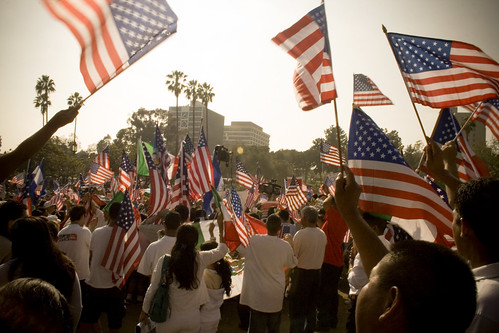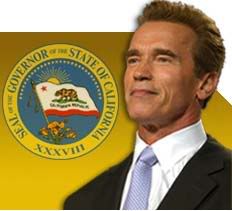
Council District Fourteen has received a request that the City provide certain services and declare this function a Special Event. Approval of this request
will mean that the City will absorb an estimated $162,977 in fees and salary
costs.
I THEREFORE MOVE that the "L.A. Fiesta Broadway 2008" be declared a Special Event, and City departments be requested to waive all fees and costs,except insurance and application requirements.
Don’t get me wrong, there’s nothing I love more than a good party; but it seems to me that if the City will be helping to cover the costs of one of the biggest events occurring in the heart of its Civic Center, it should be more culturally inclusive than it is right now.
I know I’m dating myself with this little walk I’m about to take down memory lane, but the history of one of L.A.’s greatest street festivals needs to be told to some of the younger folk (or the new in this town and/or country).
Back in October of 1978, the City of Los Angeles, (with the generous help of the Schlitz Brewing Co., which contributed $100,000 and the National Endowment for the Arts, which gave $40,000) held its first ever “Street Scene” at the L.A. Civic Center. The festival was bordered by Aliso St. on the north, 1st St. on the south, Los Angeles St. on the east and Broadway on the west. Angelenos were able to enjoy a diverse selection of cultural life which included: dance, drama, arts, crafts, music and food.
Sol Marcus, the chairman of the first Street Scene and then vice-president of the city’s Board of Public Works said at the time: “This is the time for Angelenos to gather, have fun, be proud of their beautiful city and see things they never knew existed in the downtown area while enjoying performances by top artists and artisans. We want them to come early, stay late and enjoy”.
Back then, parking for the day at any of the public lots was only $2.50, or you could park for free at Dodger Stadium and take a shuttle bus to the Civic Center.
Some of the acts booked for the inaugural Street Scene: Red Hot Marimba Band, Gypsy International Folk Dancers, California Boy’s Choir, Classical Ragtime Company, Dance A La Carte, Judy Garrett – mime, Korean Ethnic Heritage, Nared the Magician, Living History Theater, California Arts African Ensemble, Ramanlahi Dance Troupe, East-West Players, New American Jazz Ensemble, Dixie Belles, Oscar Nieto Flamenco, Visual Theater Workshop, Arroyo Singers of Pasadena, Ballet Mexicapan, Freddy Fender, R’Wanda Lewis Afro Dancing, Megaw Theater Puppets, Nancy Wilson, the Frankie Valli Revue, Make Believe Unlimited, Spanky Wilson, California Festival Ballet, Chuck Jones Magic, Tierra, Mormon Samoan Choir, Los Angeles Philharmonic Orchestra, Benny Howell Septet, “Skins” Afro-Cuban percussion, New Artef Players, Danny Rees – Juggler, Watts Prophets Poets, Samoan Fire Dancers, David “Fathead” Newman and the rock group Chicago, just to name a few. Some of downtown’s government buildings such as the U.S. Courthouse and the Criminal Courts Building became stage backdrops for many of the performers. A crowd estimated at somewhere between “over 10,000” (a police estimate) to an unofficial count of 30,000 all gathered in the parking lot of CCB for a light and music show.
By the close of the two-day event on Sunday night, police reported that five persons had been arrested for minor infractions. One person was taken to Queen of Angels Hospital for emergency treatment.
Other stats: There were 10 stages where more than 60 performers displayed their talents; 100 exhibitors featured arts and crafts of many nationalities and 40 booths offered foods from around the world.
Mayor Tom Bradley opened the Street Scene at a ceremony on the steps of City Hall. He told the crowd gathered there that the purpose of the festival was to try to “focus attention on the beauty and vitality of this Civic Center. We are proud of Los Angeles. We think it is one of the premier cities in the world. The people who work in the Civic Center know it intimately but there are people out there who rarely come downtown to see what’s happening.”
Lois Hale, the publicity director for the festival, said the festival was going to stay within its $140,000 budget and that the city was contributing only “in-kind services” to the event through use of municipal employees.
Of course, all good things must come to an end, and in September of 1986, after a violent weekend at that year’s Street Scene during which one person was fatally shot, 40 others injured and 35 more arrested, Mayor Tom Bradley recommended that the festival, which began as a tribute to the city’s cultural diversity – should be stopped.
Police Chief Daryl F. Gates called a news conference at the same time urging that the city-sponsored Street Scene be scrapped unless its organizers were willing to shut down the weekend event before nightfall and to stop booking “problematic” rock acts (Run DMC?).
Zev Yaroslavsky, who was then chairman of the council’s Finance and Revenue Committee proposed that the city first consider banning alcohol from its street fairs as an alternative to discontinuing the Street Scene. But seeing as how the major sponsors were beer and wine-cooler companies who were putting up the by then $700,000 annual budget, that recommendation didn’t go over so well.
Having visited the first Street Scene as a very, very, very, very young ‘tweener and being able to experience Hispanic, African, Asian, Middle Eastern, and many other ethnic influences was so exciting and inspiring to me. The sounds, the sights, the smells of all the different ethnic music, art and foods added to the mystique of Los Angeles as being one big melting pot of all types of people.
What I’d like to know is why the city is spending so much on celebrating just one aspect of our ethnic diversity when there is nothing that I know of (that compares to the vastness of Fiesta Broadway) which celebrates ALL of our ethnic diversities. I want my kids to be able to enjoy a “downtown” festival and be able to eat different types of foods, talk to and see vendors, performers and artisans from all over the world who have settled here in Southern California and specifically in the Los Angeles area, and who have so much to share culturally with all our children. Another learning experience flushed down the toilet by the politicians in charge. Why?
Why can’t we have that back – a festival for all Angelenos of every nationality to celebrate our differences as well as celebrate the (once) great city we live in and the diversity that makes us and our city unlike any other.
I’m just askin’ ….
Labels: 1978, event waivers, l.a. daily blog, l.a. fiesta broadway, l.a. street scene, zuma dogg

























